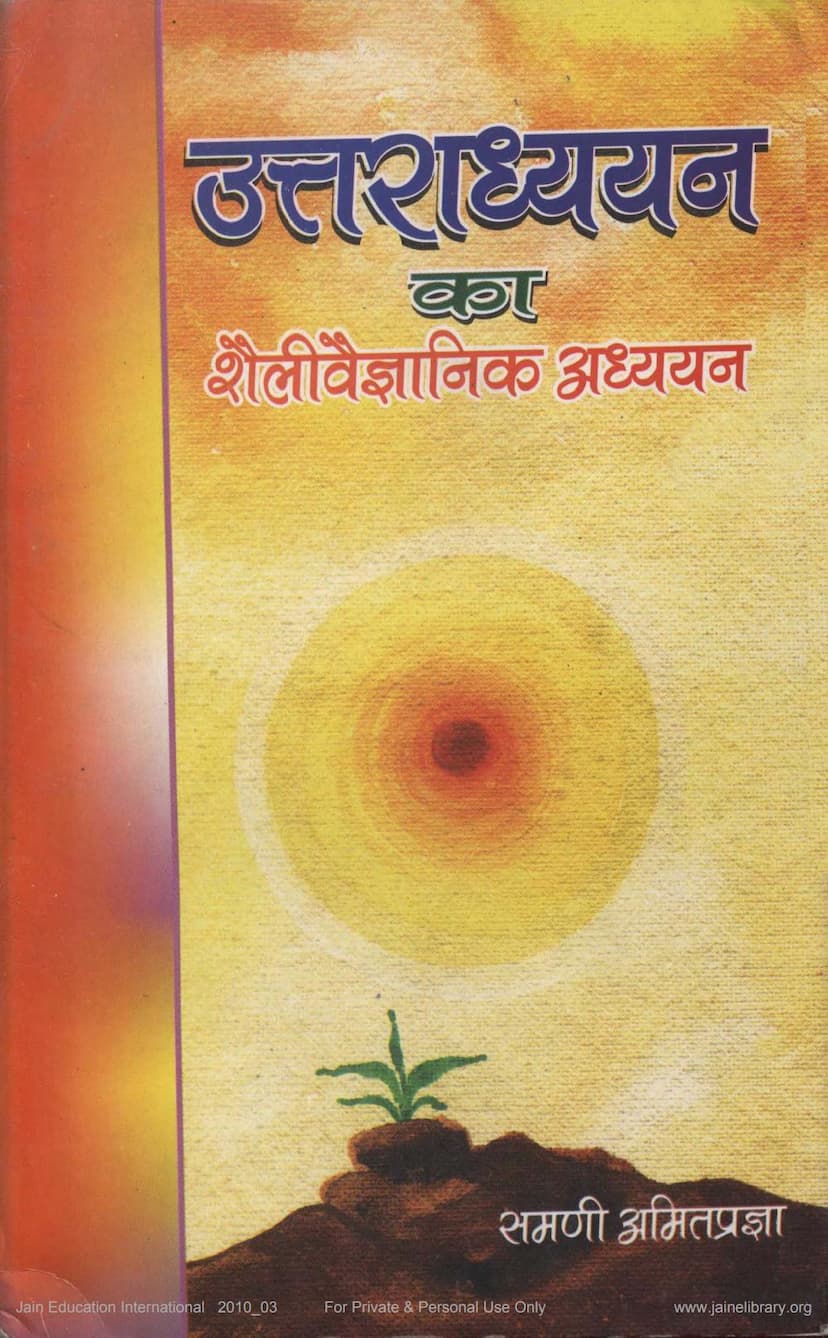Agam 43 Mool 04 Uttaradhyayana Sutra Ka Shailivaigyanik Adhyayana
Added to library: September 1, 2025

Summary
Certainly! Here's a comprehensive summary of the Jain text "Agam 43 Mool 04 Uttaradhyayana Sutra ka Shailivaigyanik Adhyayana" by Samani Amit Pragya, published by Jain Vishva Bharati:
Title: Uttaradhyayana Sutra ka Shailivaigyanik Adhyayan (A Stylistic-Scientific Study of the Uttaradhyayana Sutra) Author: Samani Amit Pragya Publisher: Jain Vishva Bharati Year of Publication: March 2005
Overall Purpose: This book presents a stylistic-scientific study of the Uttaradhyayana Sutra, a pivotal text in Jain Agam literature. The author, Samani Amit Pragya, aims to explore the literary and linguistic elements of the Uttaradhyayana Sutra from a modern stylistic perspective, demonstrating its richness as a piece of literature beyond its philosophical and religious content. The study highlights that the Uttaradhyayana Sutra is not just a dry philosophical treatise but a work of profound literary merit, often described as a "Shraman Kavya" (ascetic poetry).
Key Themes and Arguments:
-
The Significance of Uttaradhyayana Sutra:
- The Uttaradhyayana Sutra is considered a foundational text for understanding Jain Agam literature, providing sustenance throughout life.
- It encompasses elements of truth, philosophy, stories, and biographies.
- Despite its depth, some scholars have considered Agamas, including the Uttaradhyayana Sutra, as dry. This book aims to counter that notion.
- Western scholar Winterritz recognized it as "Shraman Kavya" in his "History of Indian Literature."
- The book argues that the Uttaradhyayana Sutra extensively uses poetic elements like vakrokti (indirect speech/figurative language), rasa (aesthetic sentiment), chanda (meter), alankar (figures of speech), pratik (symbol), and bimba (imagery), thus confirming its status as Shraman Kavya.
-
Stylistic-Scientific Study (Shailivaigyanik Adhyayan):
- This approach involves a comprehensive study of a text's linguistic, grammatical, and poetic aspects. It involves detailed analysis of every phrase and word.
- The study emphasizes that the Uttaradhyayana Sutra is not merely a philosophical text but is replete with all the components of excellent poetry.
- It exemplifies shaney shaney yat navataam upaiti (that which becomes new every moment is beauty) through its language.
-
Elements of Literary Style Explored:
- Symbols (Pratik) and Imagery (Bimba): The study meticulously analyzes the use of symbols and imagery in the Uttaradhyayana Sutra. It categorizes them based on their source (human world, animal kingdom, nature, etc.), their expression of auspiciousness/inauspiciousness, and their form (abstract/concrete). Numerous examples are provided, such as the mrig (deer) symbolizing the mind attracted to senses, jagati (earth) as a symbol of forbearance and support, and indriya-chor (sense-thieves) representing the five senses that steal spiritual wealth.
- Vakrokti (Indirect/Figurative Language): This is a central theme, elaborating on the theory of Vakrokti as propounded by Indian aesthetician Kuntaka. The study categorizes vakrokti into various types, including variations in letters (varnavinyas vakrata), words (padapurvardha vakrata), sentences (vakya vakrata), and narratives (prakaran vakrata, prabandh vakrata). The text provides numerous examples from the Uttaradhyayana Sutra to illustrate how vakrokti enriches the language and conveys deeper meanings, often involving subtle wordplay, irony, and implied meanings.
- Rasa (Aesthetic Sentiments), Chhanda (Meter), and Alankar (Figures of Speech): The book delves into the presence and significance of rasa (particularly Shanta and Veera), various meters like Gatha (Arya) and Anushtubh, and figures of speech like Upama (simile), Rupak (metaphor), Drushtanta (example), Shlesh (pun), Parikar, Kavyalinga, Uddhata, and Swabhavokti. The study emphasizes how these elements contribute to the poetic beauty and effectiveness of the Uttaradhyayana Sutra.
- Linguistic Structure (Bhashik Sanrachna): The book provides a detailed analysis of the linguistic aspects, including:
- Phonology (Dhvanivigyan): Changes in vowels and consonants, assimilation, dissimilation, augmentation, elision, aspiration, vocalization, etc., as found in the Prakrit of the Uttaradhyayana Sutra.
- Morphology (Padvigyan): Analysis of nouns, verbs, prefixes, suffixes, and different types of words (तत्सम - tatsam, तद्भव - tadbhava, देश्य - deshya).
- Syntax (Vakyavigyan): Examination of simple, complex, and compound sentences, and the use of interrogative, imperative, exclamatory, and conditional sentences.
- Semantics (Arthavigyan): Changes in word meanings, including expansion (arthavistar), contraction (arthasankoch), transference (arthadesh), elevation (arthotkarsh), and degradation (arthapakarsh).
-
Comprehensive Coverage: The book is structured into seven chapters, each delving into specific aspects:
- Chapter 1: Introduction to Stylistics in Uttaradhyayana Sutra: Provides an overview of Agamas, the Uttaradhyayana Sutra, its authorship, and an introduction to stylistics.
- Chapter 2: Symbols, Imagery, Aphorisms, and Idioms in Uttaradhyayana Sutra: Focuses on the rich use of these literary devices.
- Chapter 3: Vakrokti in Uttaradhyayana Sutra: The most extensive chapter, detailing the theory of vakrokti and its various manifestations in the text.
- Chapter 4: Rasa, Meter, and Figures of Speech in Uttaradhyayana Sutra: Analyzes the poetic and aesthetic elements.
- Chapter 5: Character Portrayal in Uttaradhyayana Sutra: Examines the development of characters, both human and non-human.
- Chapter 6: Linguistic Structure of Uttaradhyayana Sutra: A deep dive into the phonology, morphology, syntax, and semantics of the language.
- Chapter 7: Conclusion (Nikash): Summarizes the findings and reiterates the literary significance of the Uttaradhyayana Sutra.
-
Emphasis on Originality: The author highlights that this study is the first of its kind from a stylistic-scientific perspective, aiming to bring to light the poetic elements that might have been overlooked in traditional interpretations.
Conclusion: The book, "Uttaradhyayana Sutra ka Shailivaigyanik Adhyayan," is a significant contribution to Jain studies and literary criticism. It successfully demonstrates the artistic brilliance and linguistic sophistication of the Uttaradhyayana Sutra, showcasing it as a profound "Shraman Kavya" that resonates with timeless truths and aesthetic appeal. The study reveals the author's deep scholarship and dedication to unveiling the multifaceted beauty of this ancient Jain scripture.